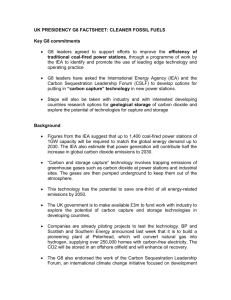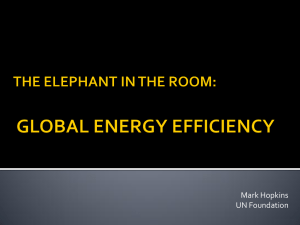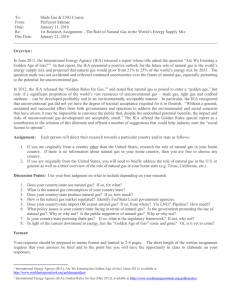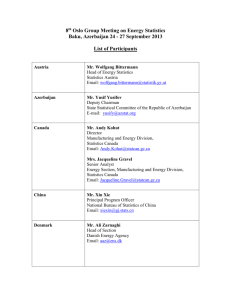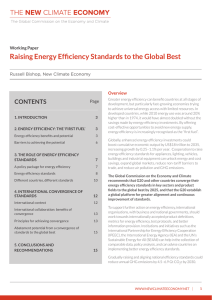Senior Fellow and Director of the Climate Policy Program, Resources... Washington, DC
advertisement
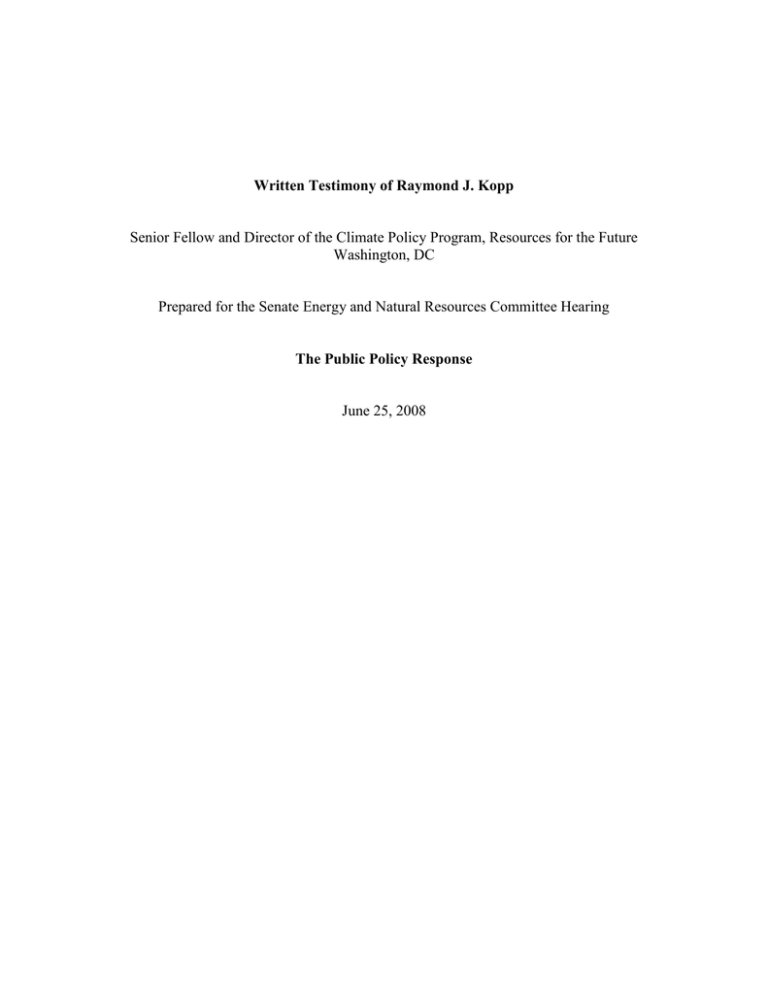
Written Testimony of Raymond J. Kopp Senior Fellow and Director of the Climate Policy Program, Resources for the Future Washington, DC Prepared for the Senate Energy and Natural Resources Committee Hearing The Public Policy Response June 25, 2008 Thank you, Mr. Chairman, for the opportunity to offer testimony before the committee about the challenges of meeting future energy needs in the context of global climate change. I am a senior fellow and director of the Climate Policy Program at Resources for the Future (RFF), a 56-year-old research institution, headquartered here in Washington, DC, that focuses on energy, environmental, and natural resource issues. RFF is both independent and nonpartisan, and shares the results of its economic and policy analyses with members of both parties, environmental and business advocates, academics, members of the press, and interested citizens. RFF neither lobbies nor takes positions on specific legislative or regulatory proposals, although individual researchers are encouraged to express their individual opinions, which may differ from those of other RFF scholars, officers, and directors. I emphasize that the views I present today are mine alone. The International Energy Agency’s (IEA) recent report, Energy Technology Perspectives 2008: Scenarios and Strategies to 2050, prepared in support of the G8 Plan of Action, provides an excellent engineering perspective on the suite of technologies and scale of deployment needed to achieve a concentration target of 450 ppm for carbon dioxide (CO2). Importantly, the IEA augments the technology information with economic estimates of cost and required investment. The report is certainly sobering in terms of investment scale, particularly with respect to investments in research, development, and demonstration (RD&D) and physical capital. At the same time, it is reassuring insofar as it identifies a feasible technology and investment path consistent with CO2-concentration stabilization at 450 ppm. While reaching this target represents an enormous technical and economic challenge, the IEA report demonstrates it is not impossible. The report reflects a good deal of our collective understanding of the challenges posed by climate change: Most importantly, there is no silver bullet. In addition to conservation, virtually all of the low-carbon technologies commercially available and those to become available over the next few decades must be deployed. Carbon pricing is crucial to providing incentives for both conservation and technology development and deployment. Governments will be required to greatly enhance spending on RD&D, and to ensure the efficiency and efficacy of that spending. Additionally, the IEA focuses attention on the global technology and investment building blocks that will be necessary to attain deep reductions in emissions. A similar analysis focused on the regional and country level would be quite valuable and I would encourage the committee to pursue such an assessment for the United States. That analysis should go beyond the IEA assessment, however, and address the specific within-country challenges to the development and deployment of non-carbon technologies and the public policies required to overcome those hurdles. If the technologies addressed in the IEA report are to be deployed at the scale suggested, removal of barriers to deployment will require a public policy response. While cost and technical feasibility will be important limiting factors, it would be unwise to overlook the suite of complementary public policies that must be developed to address technologyspecific barriers. A U.S.-based analysis of technology roadmaps akin to the IEA report should address specifically these complementary policies, some of which I’ve highlighted below. Such policies will be required for the successful implementation of all the major technologies needed to reach a 450 ppm target and extend beyond the establishment of a carbon price and the provision of additional R&D funding. Carbon capture and sequestration (CCS). Capturing and sequestering CO2 emissions from coal-fired power plants and eventually all fossil combustion is a foundational technology component of any emissions reduction plan targeting 450 ppm CO2. A carbon price, as well as greatly increased funding of related research, development, and deployment, will be crucial components to implementation. However, by themselves, policies to price carbon and accelerate R&D are unlikely to be sufficient. Regulations for the storage of CO2 must be written, storage sites selected, almost assured local opposition to storage to overcome, and a vast CO2-transport infrastructure sited, financed, and constructed. These are country-level policy concerns and therefore not addressed by the IEA report, but are nonetheless substantial barriers to the deployment of this technology. A thorough U.S. assessment of CCS would address these barriers and provide solutions. Nuclear power. The IEA report suggests that 30 percent of global energy needs could be met by nuclear power, and in the IEA BLUE scenario, global nuclear power generation triples. But such a large expansion of nuclear power will require more than a carbon price and R&D directed to new reactor design, and the issues to be resolved are substantial. Reactor safety concerns continue to limit public support for nuclear power. Long-term waste storage hangs over the head of the industry. Concerns of proliferation are very real and would be exacerbated by greatly increased growth in spent-fuel reprocessing, and a worldwide lack of skilled engineers is a drag on the expansion of the technology. These are all barriers that must be addressed by public policies in addition to carbon pricing and R&D. Bioenergy. Both for purposes of electricity generation and the production of liquid fuels for transport, bioenergy is essential in the IEA scenarios and is the largest renewable energy source. Carbon pricing is crucial to the development and deployment of bioenergy technology and technical innovation has a large role to play, but several barriers to deployment will remain. Bioenergy will compete worldwide for land used to produce food and fiber, raising the cost of all three. Accelerated bioenergy production in the United States can drive local land-use decisions and have direct impacts—both good and bad—on local rural development. Expanding the production of crops for bioenergy can affect U.S. environmental quality, including adverse impacts to biodiversity and water quality, as well as create international challenges to ecosystems and biodiversity through increased deforestation. Public policies to address the land-use issues raised by increased bioenergy production in the United States are just as important to the expansion of this technology as carbon pricing and R&D. Wind and solar power. One of the great renewable energy successes is wind-generated electricity. While it has proven to be an increasingly economical renewable energy source, it can still benefit from a carbon charge and additional RD&D. However, wind is generated where the wind blows, not necessarily where you find the electricity load centers. Transmission thus becomes crucial. The current U.S. grid is not designed to take full advantage of western or offshore wind resources. Therefore carefully planned grid expansion will be required for a large-scale increase in wind-generated electricity. This is likely true for solar as well. A greatly expanded and improved electricity transmissions grid has been a U.S. priority for at least two decades; however, given the manner in which we regulate and finance transmission, very little progress has been made. In addition, intermittency will always be a problem with wind, meaning the electricity system must be designed to accommodate for intermittency with sufficient reserve capacity, storage, and interconnected systems. Two final points Global demand for energy continues to rise, and over time, the bulk of that increase will come from non-OECD developing countries. Not surprisingly, the majority of the investment in energy-producing and -consuming technologies tracked by the IEA scenarios must take place in the same non-OECD countries. It is likely that new low- and no-carbon energy sources (coal with CCS, nuclear, and renewables, for example) will be more costly than conventional fossil sources. In OECD countries, we may be willing to bear carbon prices in the range that the IEA predicts in order to level the playing field between fossil and non-carbon technologies. However, non-OECD countries that are hard-pressed to afford current fossil technology will be less willing to bear the same carbon prices or devote scarce resources to subsidizing low- and no-carbon energy sources—certainly not in the immediate term. The obvious question unanswered by the IEA report concerns the elements of U.S. foreign policy (pursued jointly with the other OECD countries) that would lead to the necessary global deployment of the technology suite. The last point concerns time. Achieving the IEA scenarios requires the process of investment in RD&D, conservation, and physical, energy-related capital to begin immediately. Any delay means greater atmospheric concentrations in the coming years. Unfortunately, we cannot wave a magic wand and will this process to commence; rather, we must follow a slow and arduous path to develop and implement the many public policies, domestic and international, that will remove barriers and enable investment. We must buy some badly needed time and, fortunately, we have a very good option. The IEA report addresses only energy-related CO2 emissions—that is, CO2 released from the combustion of fossil fuels. Notably absent is the 15 to 20 percent of global CO2 emissions that come from land use, most importantly deforestation in tropical countries. While it is now widely known that China and the United States are the two largest CO2 emitters, it is less well-known that the countries ranking third and fourth are Brazil and Indonesia, due to widespread deforestation in these countries. Fossil-based CO2 emissions can be reduced with the deployment of non-carbon technologies, but as noted by the IEA, these reductions require large-scale investment and will take a good deal of time. In contrast, reducing CO2 emissions by reducing rates of deforestation can be accomplished with targeted domestic policies that alter the economics of land use to make a standing forest more valuable than alternative uses of the land. Using the growing international carbon market and the U.S. market that might come into being to monetize the carbon contained in standing forests will provide the economic incentives needed to alter land-use decisions. In principle, such land-use decisions could be changed very quickly, giving rise to rapid reductions in CO2 emissions. These large-scale reductions in forest-related CO2 are sure to become ever more valuable in light of the hard work ahead to achieve the needed fossil-based reductions requiring much longer lead times.
